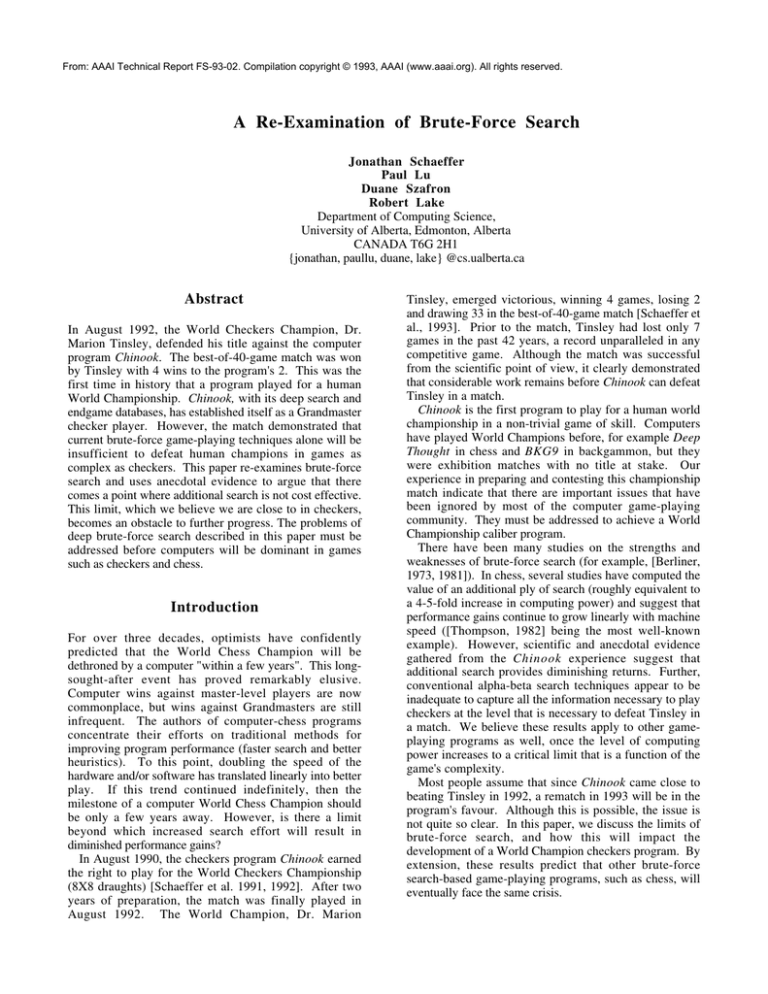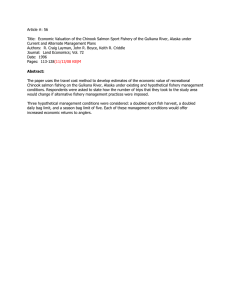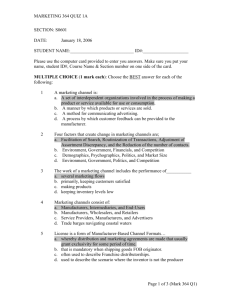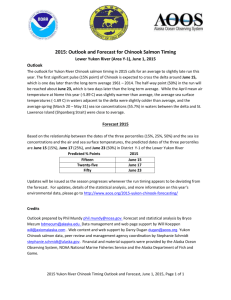
From: AAAI Technical Report FS-93-02. Compilation copyright © 1993, AAAI (www.aaai.org). All rights reserved.
A Re-Examination of Brute-Force Search
Jonathan Schaeffer
Paul Lu
Duane Szafron
Robert Lake
Department of Computing Science,
University of Alberta, Edmonton, Alberta
CANADA T6G 2H1
{jonathan, paullu, duane, lake} @cs.ualberta.ca
Abstract
In August 1992, the World Checkers Champion, Dr.
Marion Tinsley, defended his title against the computer
program Chinook. The best-of-40-game match was won
by Tinsley with 4 wins to the program's 2. This was the
first time in history that a program played for a human
World Championship. Chinook, with its deep search and
endgame databases, has established itself as a Grandmaster
checker player. However, the match demonstrated that
current brute-force game-playing techniques alone will be
insufficient to defeat human champions in games as
complex as checkers. This paper re-examines brute-force
search and uses anecdotal evidence to argue that there
comes a point where additional search is not cost effective.
This limit, which we believe we are close to in checkers,
becomes an obstacle to further progress. The problems of
deep brute-force search described in this paper must be
addressed before computers will be dominant in games
such as checkers and chess.
Introduction
For over three decades, optimists have confidently
predicted that the World Chess Champion will be
dethroned by a computer "within a few years". This longsought-after event has proved remarkably elusive.
Computer wins against master-level players are now
commonplace, but wins against Grandmasters are still
infrequent. The authors of computer-chess programs
concentrate their efforts on traditional methods for
improving program performance (faster search and better
heuristics). To this point, doubling the speed of the
hardware and/or software has translated linearly into better
play. If this trend continued indefinitely, then the
milestone of a computer World Chess Champion should
be only a few years away. However, is there a limit
beyond which increased search effort will result in
diminished performance gains?
In August 1990, the checkers program Chinook earned
the right to play for the World Checkers Championship
(8X8 draughts) [Schaeffer et al. 1991, 1992]. After two
years of preparation, the match was finally played in
August 1992. The World Champion, Dr. Marion
Tinsley, emerged victorious, winning 4 games, losing 2
and drawing 33 in the best-of-40-game match [Schaeffer et
al., 1993]. Prior to the match, Tinsley had lost only 7
games in the past 42 years, a record unparalleled in any
competitive game. Although the match was successful
from the scientific point of view, it clearly demonstrated
that considerable work remains before Chinook can defeat
Tinsley in a match.
Chinook is the first program to play for a human world
championship in a non-trivial game of skill. Computers
have played World Champions before, for example Deep
Thought in chess and BKG9 in backgammon, but they
were exhibition matches with no title at stake. Our
experience in preparing and contesting this championship
match indicate that there are important issues that have
been ignored by most of the computer game-playing
community. They must be addressed to achieve a World
Championship caliber program.
There have been many studies on the strengths and
weaknesses of brute-force search (for example, [Berliner,
1973, 1981]). In chess, several studies have computed the
value of an additional ply of search (roughly equivalent to
a 4-5-fold increase in computing power) and suggest that
performance gains continue to grow linearly with machine
speed ([Thompson, 1982] being the most well-known
example). However, scientific and anecdotal evidence
gathered from the Chinook experience suggest that
additional search provides diminishing returns. Further,
conventional alpha-beta search techniques appear to be
inadequate to capture all the information necessary to play
checkers at the level that is necessary to defeat Tinsley in
a match. We believe these results apply to other gameplaying programs as well, once the level of computing
power increases to a critical limit that is a function of the
game's complexity.
Most people assume that since Chinook came close to
beating Tinsley in 1992, a rematch in 1993 will be in the
program's favour. Although this is possible, the issue is
not quite so clear. In this paper, we discuss the limits of
brute-force search, and how this will impact the
development of a World Champion checkers program. By
extension, these results predict that other brute-force
search-based game-playing programs, such as chess, will
eventually face the same crisis.
Chinook
Chinook's strength comes from deep searches (deciding
which positions to examine), a good evaluation function
(deciding how favorable a position is), an opening book
(knowledge of the first few moves of the game) and
endgame databases (perfect information on all positions
with 7 pieces or less and the important 8-piece positions).
The program is similar in structure to its chess
counterparts, with the exception of the endgame databases
which play a major role in checkers but only a minor role
in chess [Schaeffer et al., 1992].
Chinook uses a parallel iterative alpha-beta search with
transposition tables and the history heuristic. During the
World Championship match, the program searched to an
average minimum depth of 17-, 19- and 21-ply (one ply is
one move by one player) in the opening, middlegame and
endgame respectively, under the condition of having to
play 20 moves per hour. The search uses selective
deepening to extend lines that are tactically or positionally
interesting. Consequently, major lines of play are often
searched many ply deeper. It is not uncommon for the
program to produce analysis that is 30-ply deep or more.
The program's evaluation function has 25 heuristic
components, each of which is weighted and summed to
give a position evaluation [Schaeffer et al., 1991]. The
game is divided into 4 phases, each with its own set of
weights. The definition of the heuristics and their weights
was arrived at after long discussions with a checkers
expert. This allowed us to obtain sufficient knowledge to
play a strong game of checkers. The evaluation function
is constantly being tuned using human knowledge, the
results of playing different versions of Chinook against
itself and the experience gained from games against human
Grandmaster opposition.
We have enumerated all checkers positions with 7 or
fewer pieces on the board (checkers or kings) and all of the
4 against 4 subset of the 8-piece positions (only 40% of
the 8-piece positions were available for the Tinsley
match). For each board position, its value - win, loss or
draw - has been computed so that the program has perfect
information. This represents a database of 150 billion
positions. Although some humans can play endgames
with 6 or fewer pieces on the board nearly perfectly, the
complexity of 6-piece endgames is such that there are
many positions that humans do not understand. Chinook
knows the value of every one of these positions without
error. The 4 against 4 subset of the 8-piece database
significantly extends the gap between the program's
perfect information and the human's heuristic knowledge.
Extensive knowledge of the openings is important if
one is to play for a World Championship. Chinook has a
small opening library of roughly 6,000 positions. It
consists of both prepared lines and an antibook. Chinook
has consistently shown that on its own, it often finds
interesting opening innovations and we do not want to
stifle its creativity. On the other hand, some of these
moves are known by humans to be losing, even though
Chinook cannot detect this under game constraints. To
solve this problem, we maintain an antibook, a library of
moves not to make. The antibook allows Chinook to
play its own openings, while avoiding those moves that
are known to be losing.
Search and Knowledge
Game-playing programs usually trade off knowledge for
search. As shown in Figure 1, identical performance
levels can be achieved by search-intensive or knowledgeintensive programs. The isobars are on a logarithmic
scale and represent increasing levels of performance.
Improving one dimension, without decreasing the other,
allows one to move to a new performance level. In the
World Championship match, Tinsley made two errors in
roughly 1000 moves, 99.8% accuracy, while Chinook
made 4 errors, 99.6% correct. The intersection of the two
dashed lines represents the Chinook data point, the
performance being a function more of search than of
knowledge. By comparison, the Tinsley data point (99.8)
has a larger knowledge component than search.
Chinook's search performance is largely a function of
three components: the alpha-beta search algorithm with
the usual enhancements, heuristics for extending the
search along interesting lines, and hardware speed to
increase the number of nodes searched beyond a base level
(for example, a typical workstation). The knowledge
dimension consists of evaluation function heuristics,
opening knowledge (opening book or antibook) and
endgame databases (knowledge gained through retrograde
search). Thus there are 6 major areas where effort can be
concentrated to improve the program's play (see Figure 2).
Since additional search is usually easy to achieve, the
most cost-effective approach for improving program
performance is to find hardware and/or software ways for
improving the number of nodes searched per second. The
harder problems, such as acquiring and integrating
knowledge, historically have achieved scant attention but
this is changing [Donskoy and Schaeffer, 1990]. Many
chess programmers have subscribed to the philosophy of
maximizing performance with minimal effort, adopting
the path of least resistance.
Tinsley
K
N
O
W
L
E
D
G
E
Chinook
Accuracy
99.8
99.6
99.0
96.0
90.0
80.0
SEARCH
Figure 1. Performance isobars as a function of search and knowledge.
K
N
O
W
L
E
D
G
E
Endgame
Databases
Opening
Book
Evaluation
Heuristics
Alpha-Beta
Extensions
Speed
SEARCH
Figure 2. Improving search and knowledge.
The Search Dimension
There are a number of problems that must be overcome in
Chinook before the program can achieve the pinnacle of
the checkers world. Surprisingly, most of these problems
relate to the inadequacy of conventional brute-force alphabeta search.
Diminishing Returns for Deeper Search
Chinook's early success in 1990, when it earned the
right to play for the World Championship, seemed to
indicate that it might be an easy task to conquer the
checkers world. Perhaps a few more ply of search were all
that was necessary. However, after two years of work,
Chinook had increased its search depth by 2.5 ply,
improved its knowledge with an improved evaluation
function and better opening knowledge, and extended its
endgame databases, but was still not World Champion. A
checker Grandmaster has suggested that Chinook circa
1992 is only marginally better than Chinook circa 1990.
Compared to computer chess, where additional search
translates into significant performance gains [Thompson,
1982], this seems rather strange and requires an
explanation.
Our experience with Chinook suggests that performance
gains are not linear with search depth for deep searches.
Rather, as performance improves, the expected return from
additional search depth decreases. This result is
represented in Figure 3, which plots the degree of
perfection in the program (probability of making a good
move) versus the depth of search (fixed depth search,
ignoring the search extensions common in most
programs). Obviously, if one could search infinitely
deep, the program would never make an error. However,
given a depth constraint, there will always be some
positions that the program will be unable to play
correctly. As search depth increases, this likelihood
decreases. Unfortunately, the decrease is not linear.
In chess, with the top programs searching roughly 10
ply (position dependent, of course), the benefits of an
additional ply of search (shown as bold dashed lines in
Figure 1) are significant because the performance gains
curve has not yet tapered off significantly. Chinook,
however, is further along on the curve, where an additional
ply of search translates into marginal gains (shown as the
thin dashed lines in Figure 3). Of course, using the same
graph for both games, with their differing complexities, is
perhaps not a fair comparison. Nevertheless, we speculate
that both games follow similarly shaped curves.
Thompson's study of the effect on performance of an
additional ply of search in chess showed that through
depth 8, an additional ply improved program performance
linearly. A program searching 4-ply deep defeated a
program searching 3-ply by the score of 16-4 in a match
of 20 games. However, an 8-ply program defeated a 7-ply
program by a similar 16.5-3.5 score. This result has been
used by a number of parties, including the Deep Thought
chess team, to extrapolate to the number of ply needed to
defeat the World Champion.
Degree of Perfection
Perfect
Random
0
10
20
30
Depth
Figure 3. Performance as a function of depth.
40
Shallower
Searching
Program
Depth
5
7
9
11
13
15
17
19
5
7
14.0
6.0
Deeper Searching Program
9
11
13
15
17
19
15.0
5.0
12.50
7.50
11.50
8.50
10.5
9.5
11.0
9.0
9.5
10.5
Table 1. Match results between programs searching to different depths.
Thompson's experiment has been repeated with
C h i n o o k . A program searching to depth i (plus
extensions) would play a 20-game match against a
program searching to depth i+2. (In Chinook, the search
depth is always incremented by two because it introduces
more stability into the search.) The cost of searching an
additional two ply in checkers is roughly a factor of four
in computing time, similar to the factor required to search
an additional single ply in chess. Table 1 illustrates the
results for depths 5 through 19. The results are noisy but
give the general trend that from depths 5 through 11, an
additional 2 ply of search represents a significant
improvement in program performance. However, as the
depth approaches 19, the benefits of deeper search taper
off; the law of diminishing returns takes over.
Statistically, as the search depth increases, the likelihood
of an additional 2 ply of search uncovering an error by the
opponent declines. Plotting the results from Table 1
yields a graph similar to Figure 3.
Surprisingly, the 17-ply program defeated the 19-ply
program by one game. However, an additional 20 games
resulted in an even match and the results are well within
the margin of error for such an experiment. A possible
explanation for this unusual result is that the 19-ply
program might have been handicapped by the evaluation
function. Chinook's evaluation function is tuned using
15-ply searches. We have observed occasional instances
where improvements to the evaluation function translate
into better play when searching 15-ply deep, but produces
mixed results with deeper searches. In fact, in one of the
games lost by the 19-ply program, the losing move would
not have been made if only a 17-ply search had been
conducted.1
A 1000-fold Faster Computer Isn't Enough
Given that the improvement in Chinook's play versus
depth of search graph is not linear, is it conceivable that
continuing technological improvements could eventually
compensate for this non-linearity? That is, although it
might require a speed-up of 1000 to produce an
improvement of 10 ply in the search, would the additional
1 Note that, in general, it is difficult for us to identify
losing moves by Chinook. In some cases, only Marion
Tinsley has the ability to identify our errors.
plys of search be sufficient to effectively reduce the
probability of error to zero? Unfortunately, there is a
growing body of anecdotal evidence to support the idea
that there are some critical lines that even an improvement
of 10-ply would not even begin to address.
1) In an exhibition match against Tinsley in 1990,
Chinook played its 10th move and, on the basis of a
17-ply search, claimed a small advantage. Tinsley
immediately said we would regret that move. On
move 25, Chinook realized it was in difficulty and we
resigned on its behalf on move 35. After the game,
Tinsley revealed that on move 12 he had seen to the
end of the game and knew he was going to win. Our
best estimate is that he was doing selective searches
of over 60 ply.
2) In the 1992 Tinsley-Chinook match, Chinook won
games 8 and 14. In both cases, Tinsley said he
realized he was lost immediately after making the
fatal move. In game 14, it took C h i n o o k an
additional 12 moves (24 ply) before a 21-ply search
found the win. That is, although Chinook found the
best moves in game 14, it did so without knowing it
was winning.
3) In the well-known and feared White Doctor opening
(game 39 of the match), black must sacrifice a man
on move 4 or lose. This result took decades of
human analysis to arrive at. Chinook, when facing
this position without its antibook, cannot find the
right move, even with 48 hours of compute time
(about 1000 times more search).
4) In game 5 of the 1992 Chinook-Tinsley match,
Chinook played its first 10 moves from its opening
book using a defense found in an authoritative human
authored book on the checkers openings. At this
point, the program was lost. On querying the author
of the book after the match, his response was that he
knew the line was a mistake and that it should never
have been included in his book. All positions in
Chinook's opening book have been "verified" by 19ply searches. Unfortunately, in this case a
considerably deeper search is required to uncover the
problem.
Most positions do not require 30 ply to find the correct
answer. However, there are critical positions where
searching beyond that depth is mandatory.
It is obvious that Tinsley, with his highly selective
knowledge-based algorithm, out-performs Chinook. An
extra 2 ply of search (possible with current technology in
a year) would reduce the chances of Chinook making a
mistake. However, it would only go a small way towards
overcoming Tinsley's knowledge advantage.
There are two major search problems. First, the searchdepth/game-performance graph is non-linear. Second,
there is a wide gap between existing search depths and
required search depths for many critical game lines. Are
these problems unique to checkers? If not, then what does
this imply for chess, where the Deep Thought team
confidently expect their faster hardware to propel them to
the World Chess Championship?
Using brute-force search techniques (with selective
search extensions), we know that even a 1000-fold
increase in compute power (10 ply) will be inadequate to
solve some problems under tournament conditions
(average 3 minutes per move). As illustrated by the
White Doctor, over 200 years of human analysis has been
spent identifying the critical positions in checkers and
searching for the truth. How can a program be expected to
find the correct move in 3 minutes? The solution has
always been to add such positions to a program's opening
book. The program need not understand the reason, but
when it reaches the critical position, it retrieves the correct
move from its book and plays it. This suggests we can
overcome this search obstacle by adding all the checkers
literature to Chinook's knowledge.
Needless to say, from the artificial intelligence point of
view, this is not satisfactory. However, even if it were
feasible, there is still a search obstacle to overcome. The
literature is full of mistakes. Many of the errors are
typographical and can be easily caught and corrected. The
more serious ones, such as mistakes in analysis, are more
difficult to detect. We (naively) thought that a 15-ply
search was sufficient to find most of these errors, but we
were wrong. A subsequent pass through our collection of
opening positions doing 19-ply searches uncovered several
more errors. We could continue this process, using deeper
searches, but it becomes computationally prohibitive and
we must deal with the non-linear relationship between
benefits and effort expended. As is obvious from 4)
above, we can take nothing for granted in the literature if
we want to succeed in building a World Champion
checkers program.
The Knowledge Dimension
In most game playing programs, including chess and
checkers, some human knowledge is replaced by deep
search. What happens when additional search depth
provides limited utility? Deep Thought searches millions
of positions per second. Surely that must be more than
adequate to achieve the pinnacle of the chess world.
Perhaps the search depths achieved are adequate, but the
knowledge gained from that effort is insufficient.
Alpha-Beta Search Provides Insufficient
Information
The result of an alpha-beta search is a "best" move and
its value. Is the highest minimax value an adequate
definition of the "best" move? Consider the following
events from the Chinook-Tinsley match.
1) In game 26, Chinook chose a move that preserved a
small advantage which quickly petered out into a
draw. The audience expected a different move and
thought that the program was winning. Chinook had
seen far enough ahead that it could prove that the
critical line was a draw. In fact, the draw was quite
difficult for a human opponent to achieve, there being
a narrow (and not obvious) line to follow. The
program searched beyond the resolution point of the
opponent's problem and simply returned the "best"
move with no consideration for the difficulty that the
opponent would face in achieving success in practice.
2) In game 37, deep searching and the endgame databases
allowed the program to announce the game drawn on
move 5! Of course, the game continued since there
was always a chance that Tinsley could make a
mistake and lose. In this situation, the program
should choose between drawing lines, trying to
maximize the probability of the opponent making a
mistake.
3) In game 25, Chinook 's search discovered a long,
complicated win for Tinsley. The program decided to
sacrifice a checker immediately to gain some counterplay which quickly dissipated and the program lost
easily. The program should have played the main
line to see if Tinsley had found the win, even if it
resulted in a quicker loss.
These three examples illustrate the point that minimaxing
of evaluation scores does not necessarily result in a move
choice that maximizes the practical chances of the
program.
Consider the extreme case where the search is deep
enough that Chinook never makes a losing move
(assuming checkers is a draw with perfect play). Is this
sufficient to defeat Tinsley? Perhaps, but given Tinsley's
level of perfection, a match could end up as a draw. The
program will always play a correct move, but given a
choice of moves with equal minimax values, the choice
will be random as to which is selected. Obviously, the
correct decision is to choose the move that preserves the
game result and maximizes the probability of an error by
the opponent. This approach may not defeat Tinsley, but
it would increase the likelihood. It is the difference
between having a program that is sufficiently good, and
one that is arguably the best.
The best move, in the context of alpha-beta, is the one
that maximizes the heuristic score. However, there are
other criteria for the best move that alpha-beta fails to
capture. For example, the best move might be the one
that leads to an easy draw, offers the opponent the most
chances to go wrong, or reduces the uncertainty in the
position. It is possible to enhance alpha-beta search to
capture some additional useful information, such as
winning probabilities or approximations of error, but
unfortunately this means gathering information from
nodes that are normally cut off. Without the alpha-beta
cutoff, and the exponential reduction in search effort that it
provides, the algorithm will lose some of its
effectiveness. There are alternative search methods that
attempt to capture more information in the search (B*
[Berliner, 1979] or Conspiracy Numbers [McAllester,
1988], for example). However, none of these promising
approaches have, as yet, been able to favorably compete
with alpha-beta.
In the traditional formulation of the alpha-beta
algorithm, the evaluation function is applied to positions
at the leaves of the search tree and min/maxed back to the
root. Our experience suggests that heuristic evaluations
should be applied to sequences of moves instead of just
individual positions. The value for a move should be a
function of the position reached and the move sequence
(path) used to reach the position. Because of
transpositions, it is possible that the same position can be
reached by two different paths. Thus a modified alphabeta algorithm might use path-independent heuristic
evaluations of leaf nodes, and modify the score backed up
at each interior node based on the path to that node.
What path-dependent features should influence the
evaluations? Clearly, we want to capture some measure
of difficulty. A simple heuristic that has been suggested
is that one should factor into the score the number of
viable alternatives the opponent has at each point along
the path. If the ratio of the number of viable moves to
the total number of choices is small, there is a greater
chance of the opponent making a mistake. Thus, a line of
play where the opponent has only one viable move in
each position would be considered difficult.
Unfortunately, this does not take into account the
"obviousness" of these forced moves. The advantage of
this heuristic is that there are existing enhancements to
alpha-beta, such as singular extensions [Anantharaman et
al., 1990], to detect forced sequences. The "first among
equals" strategy attempts to use search information to
identify non-obvious forced moves [Levy, 1991].
Chinook, like most chess programs, assumes that its
opponent's computational model is identical to its own.
Its deep search allows it to find positional and tactical
motifs that no other human can, except possibly Tinsley.
As points 1) and 3) above illustrate, the assumption that
the opponent can see everything that the program can is
false for most players. There comes a point in the
analysis of the line where the probability that the
opponent cannot see the correct resolution of the analysis
must be taken into account.
Some knowledge of the opponent's computational
model is needed to properly compute a difficulty measure.
For example, a well-known psychological obstacle faced
by chess players is the tendency to overlook the retreat of
a well-placed piece in their analysis. A line of play
which requires the opponent to see this possibility offers
some practical chances for a mistake. To properly
implement such a scheme, one needs a model of the
opponent, usually not an easy thing to attain. Peter
Jansen has made the first attempts at using information
about the opponent to influence search decisions [Jansen,
1992].
Finally, the only chance of surprising a Grandmaster in
the opening is to play an unusual move. Of course,
Chinook is programmed to always play the strongest
move. Unfortunately, the move it usually chooses is also
considered best by human players and has been extensively
analyzed in the literature. Hence there is less opportunity
to test the opponent's ability to find the right reply than
to test the opponent's memory. There is a vital need for
the program to occasionally play the second or third best
move in a position to catch the opponent by surprise.
Unfortunately, in the traditional game-playing program
structure, this is not easy to do.
Combining Different Evaluation Functions
Besides the problem of tuning an evaluation function
mentioned earlier, there are other knowledge related
problems that arise as a consequence of deep search.
Different knowledge is needed at different stages of most
games. Therefore, most chess-playing programs have
several evaluation functions, one for each phase. Usually,
chess programs select a single evaluation function, based
on the position at the root of the search tree and it is used
for the entire search. Since the search is usually not very
deep (usually less than 12 ply even with extensions), a
line of play crosses game phase boundaries infrequently.
The situation is different in checkers. On the first move
of the game, with all 24 checkers in their starting
positions, a 15-ply search with extensions already reaches
some positions in the endgame databases (8 or fewer
pieces on the board). During this search, positions from
the opening, middlegame, endgame and databases are all
considered, each with its own evaluation function.
Minimaxing scores from different evaluation functions
causes problems unless these functions are normalized so
that a score from one function has precisely the same
winning chances as the same score from another function.
This is very difficult to achieve in practice, since the
knowledge used in these functions is so disparate. How
does one compare the value of positive features in the
opening with those in the endgame?
Since this problem only arises because of deep search, a
solution cannot be found in the choice of search algorithm
per se. Rather, the problem is in the development of the
evaluation functions and the methods for comparing their
values and backing them up. Comparing values based on
only one dimension, the minimax score, is too naive. In
our checkers experience, small advantages in the opening
should out-weigh larger advantages in the endgame since,
in the former case, there is still plenty of play left before
the game is over (more chances for the opponent to go
wrong).
Conclusions
Chinook is yet another demonstration of the potential for
brute-force computations. Largely on the basis of deep
searching and endgame databases, Chinook has established
itself as one of the best checker players in the world.
However, this traditional approach to building gameplaying programs appears to be inadequate to defeat the
best player in the world. In particular, we believe that a
few extra ply of search will be inadequate to eliminate the
performance gap between Tinsley and Chinook.
Adopting the path of least resistance, most of the work
on Chinook is concentrated on the opening knowledge and
endgame databases, in addition to research on the problems
outlined in this paper. Acquiring more opening
knowledge is of significant benefit to Chinook, given the
small number of moves in its opening book. Although
this has its share of danger, this rote learning has not yet
reached its point of diminishing returns. In addition, each
endgame database adds more perfect knowledge to the
program, something Tinsley cannot compete with. Since
this is now an automated process, the program can
continue to improve without human intervention.
Tinsley's remarkable record shows what humans are
capable of and, if we are to succeed, what we must do to
defeat the best of human abilities. The human spirit,
when confronted with a challenge, is capable of putting
forth the extra effort necessary to raise their abilities
beyond what they can normally achieve. As Chinook
improves, we believe Tinsley's abilities will grow to
match ours.
The problems discussed in this paper will eventually
have to be addressed by the computer chess community.
Unfortunately, in chess, gains can still be made by
building faster searchers. Until deeper search starts
yielding diminishing returns for performance benefits,
these problems will continue to be neglected.
Acknowledgements
Many people have contributed to Chinook over the
years, including Norman Treloar, Joe Culberson, Brent
Knight and Steve Sutphen. This research was supported
by the Natural Sciences and Engineering Research Council
of Canada, grant number OGP 8173. The support of Bob
Bishop and Silicon Graphics International is greatly
appreciated.
References
T.S. Anantharaman, M.S. Campbell and F-h. Hsu.
Singular Extensions: Adding Selectivity to BruteForce Searching. Artificial Intelligence, vol. 43,
no. 1, pp. 99-110, 1990.
H.J. Berliner. Some Necessary Conditions for a Master
Chess Program. International Joint Conference on
Artificial Intelligence, pp. 77-85, 1973.
H.J. Berliner. The B* Tree Search Algorithm: A Best
First Proof Procedure. Artificial Intelligence, vol.
12, no. 1, pp. 23-40, 1979.
H.J. Berliner. An Examination of Brute Force
Intelligence. International Joint Conference on
Artificial Intelligence, pp. 581-587, 1981.
M. Donskoy and J. Schaeffer. Perspectives on Falling
from Grace. Chess, Computers, and Cognition,
T.A. Marsland and J. Schaeffer (editors), Springer-
Verlag, pp. 259-268, 1990. Also reprinted in the
Journal of the International Computer Chess
Association, vol. 12, no. 3, pp. 155-163, 1989.
P. Jansen. Using Knowledge About the Opponent in
Game-Tree Search. Ph.D. thesis, Department of
Computer Science, Carnegie-Mellon University,
1992.
D.N.L. Levy. First Among Equals. Journal of the
International Computer Chess Association, vol.
14, no. 3, pp. 142, 1991.
D.A. McAllester. Conspiracy Numbers for Min-Max
Search. Artificial Intelligence, vol. 35, pp. 287310, 1988.
J. Schaeffer, J. Culberson, N. Treloar, B. Knight, P. Lu
and D. Szafron. Reviving the Game of Checkers.
Heuristic Programming in Artificial Intelligence;
The Second Computer Olympiad, D.N.L. Levy and
D.F. Beal (editors), Ellis Horwood, London, pp.
119-136, 1991.
J. Schaeffer, J. Culberson, N. Treloar, B. Knight, P. Lu
and D. Szafron. A World Championship Caliber
Checkers Program. Artificial Intelligence, vol. 53,
no. 2-3, pp. 273-290, 1992.
J. Schaeffer, N. Treloar, P. Lu and R. Lake. Man versus
Machine for the World Checkers Championship.
AI Magazine, vol. 14, no. 2, pp. 28-35, 1993.
K. Thompson. Computer Chess Strength. Advances in
Computer Chess 3, M.R.B. Clarke (editor), pp. 5556, Pergamon Press, 1982.





